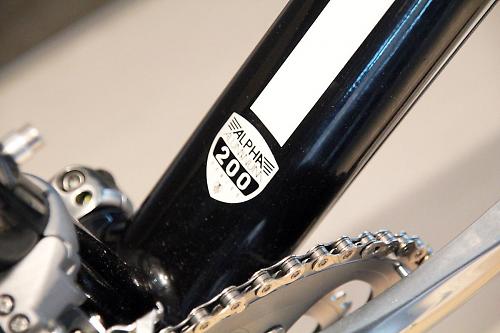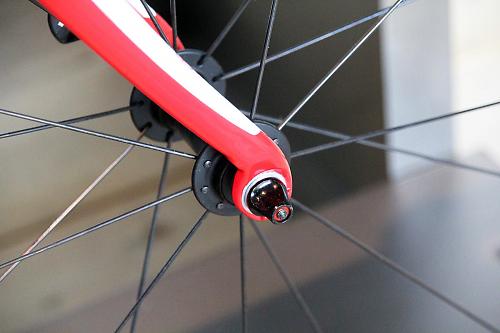- News
- Reviews
- Bikes
- Accessories
- Accessories - misc
- Computer mounts
- Bags
- Bar ends
- Bike bags & cases
- Bottle cages
- Bottles
- Cameras
- Car racks
- Child seats
- Computers
- Glasses
- GPS units
- Helmets
- Lights - front
- Lights - rear
- Lights - sets
- Locks
- Mirrors
- Mudguards
- Racks
- Pumps & CO2 inflators
- Puncture kits
- Reflectives
- Smart watches
- Stands and racks
- Trailers
- Clothing
- Components
- Bar tape & grips
- Bottom brackets
- Brake & gear cables
- Brake & STI levers
- Brake pads & spares
- Brakes
- Cassettes & freewheels
- Chains
- Chainsets & chainrings
- Derailleurs - front
- Derailleurs - rear
- Forks
- Gear levers & shifters
- Groupsets
- Handlebars & extensions
- Headsets
- Hubs
- Inner tubes
- Pedals
- Quick releases & skewers
- Saddles
- Seatposts
- Stems
- Wheels
- Tyres
- Health, fitness and nutrition
- Tools and workshop
- Miscellaneous
- Tubeless valves
- Buyers Guides
- Features
- Forum
- Recommends
- Podcast
news
Trek unveil £1,000 Domane 2 series
We're over at Trek World Europe in Frankfurt at the mo having a look at the fresh goods from Trek and Bontrager. You've probably already seen that they've got Fabian Cancellara's Trek Domane from the Tour over here, but that's not the only interesting Domane on show. There's also one, believe it or not, that you can get on Cyclescheme.
A Domane for £1,000? That's right. Obviously it's not a pro-level, OCLV Carbon dream machine like Fabian's bike, but it's interesting nonetheless. Essentially, Trek have brought the IsoSpeed technology to an Aluminium frame and called it the Domane 2 series.
If you're not up to speed with the IsoSpeed decoupler, then the basic premise is this: in order to tune the ride of the bike at the seatpost, it's better if you don't have to deal with the fact that it's bonded to the top tube and seat stays. That way you've got all of the seat tube to play with, rather than just the top couple of inches.

The IsoSpeed decoupler isolates the seat post from the top tube and stays so that it can flex independently. Trek are very careful not to talk about the decoupler as a pivot, as it's not really acting as a pivot in the way most people would understand from a suspension setup. In purely engineering terms, though, that's basically what you have, hidden by a rubber insert that's simply there to keep the junction clear of grime; it doesn't perform any damping duties.

The fact that the seatpost is decoupled from the frame at that point means it can be much more compliant; in the Carbon bikes compliance is increased over the Madone from 23mm to 35mm. We don't have figures for the Aluminium bike just yet, but we'd expect it, like the Carbon frame, to be a significant difference. To build the bike in Aluminium with the decoupler throws up a whole set of new problems, not least the fact that Aluminium fatigues over time in a way that Carbon doesn't. But Trek are happy that they've got the Domane 2 series frame dialled in terms of compliance for the rider and stiffness for the power in the same way as the higher-end models.

Up front the Domane 2 series has a Carbon IsoSpeed fork that uses the same design as the more expensive bikes in the range, with the fork blade arcing over the top of the dropout to give more vertical compliance at the front too. The Domane 2.0 is built up with 10-speed Tiagra running gear and a compact chainset for exactly a grand. If you want 105 components then there's a Domane 2.3 that's a couple of hundred quid more. We've put our names on the list for one of the entry-level bikes, so stay tuned for a just-in and a review.
Dave is a founding father of road.cc, having previously worked on Cycling Plus and What Mountain Bike magazines back in the day. He also writes about e-bikes for our sister publication ebiketips. He's won three mountain bike bog snorkelling World Championships, and races at the back of the third cats.
Latest Comments
- Secret_squirrel 58 min 29 sec ago
Yup - there now. Probably content mgt systems refreshing...
- JoanneH 1 hour 18 min ago
I've just invested in a new bike and it's got 165mm cranks, which were both the crank length associated with the frame size but also what my bike...
- Rendel Harris 1 hour 19 min ago
As one had every reason to suspect, your video proves there is absolutely no justification in the police pursuing this action against you. Your ...
- Smidge69 1 hour 36 min ago
Im not at all happy with these. I have them in 34. The issue is that the rubber is sufficiently soft, tacky (and presumably therefore grippy) that...
- chrisonabike 1 hour 53 min ago
Amen, brother....
- Rendel Harris 2 hours 19 min ago
I really wish the powers that be would station a few security guards in the crowd at big events like the world championships and tell them to grab...
- bensynnock 2 hours 30 min ago
I think they're probably more happy with the 20mph limits and then just driving as fast as they like, as they do currently.
- ACyclingGuitarist 3 hours 7 min ago
I ride to and from Manchester from where I am (just out of Bolton) and the standard of driving you see is shocking, from both a cycling and driving...
- JRogerson 3 hours 43 min ago
I'd be cautious with the £10 per month TNT offering and your expectation of what you'll get. I suspect it will simply be access to the channels....
- The_Ewan 3 hours 54 min ago
If they also have the abilty to switch from dipped to 'full beam' they'd be interesting to know about....

































































































































Add new comment
9 comments
Also, is my experience that hands and feet always numb long before the arse does atypical? If I were designing for me, I'd do something like sliding, elastomer-sprung fork dropouts long before I'd think of something like this. That said, I do usually ride steel frames with 27.2 seatposts (sometimes carbon ones).
the fork's been redesigned of course and the higher end models have trek's new isozone bars with built-in pads (more on them later). i don't *think* the 2 series domanes have the bars. they do have the fork though.
Steff - your experience is not atypical, I've often heard people complain of hands and shoulders and neck suffering before rear end (experience from owning a bike shop once, and being a cyclist for over 40 years inc. clubs). I'm just the same, my first thought was also 'what about the front end, surely that should come first'?
Most of the time I ride a full carbon frame, seatpin, and bars, but lately I've been experimenting with 'compliance modification' on a 631 steel frame (Bob Jackson Club Audax). I've tried 23, 25 and 28c tyres, carbon bars, double bar tape, carbon seatpin, and even a USE carbon suspension seatpin.
The tyres seem to make the most difference. The suspension pin obviously soaks up bumps but doesn't seem to smooth out vibration, which maybe it isn't supposed to, as this would presumably also soak up some of your effort. Carbon bars don't seem to be much different from alloy in vibe control - I've tried three different types of carbon bar, 3T, an unnamed far-east one, and Pro - no apparent difference in damping. Front end mods., then, seem to me, so far, to be mostly affected by tyres. I've also tried 32spoke in a 3x pattern as opposed to radial spoking, again a minimal difference. Double bar tape feels better on rough surfaces, helped a lot more by loosening your grip over cobbles and the like.
These are all just subjective, amateurish impressions of course: I would love to see some sort of more objective, scientific type testing of the 'compliance' of all these aspects, if one were devisable.
Also, is the Trek frame going to be available as a frame only? I'd love to try it but could not live with that Shimano stuff.
Blimey - that's brave of them. Considering the number of cracked-at-the-bottom-bracket frames I've seen (mostly aluminium, but steel and titanium too) freeing the seatpost to act as a long lever on the BB indicates either a remarkable degree of confidence in their metallurgy and process or control or a worrying triumph of optimism over experience.
Well, this certainly seems to fly in the face of engineering logic and the properties of aluminium....thats a material you wouldnt expect to be used where the design relies on repeated flexing of a tube !
Treks material science engineers are much more qualified than me however so all credit to them, I do wonder just how few of these are likely to be on the second hand market in 5 years time.
No, it's not a weld, it's a reflection - if you look carefully you can see my legs
WHOAAA!!
Sora's not the lowest in the Shimano order now, there's a new Tourney.
You've probably all heard about this though, haven't you.
Is that a huge badly finished weld on the pic of the seat tube? seriously ugly.
WHOAAAAAAAAA
NEW SORA!!!!!!!!